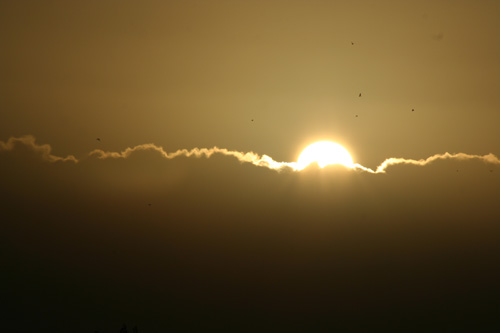
Both photos in this post are courtesy of Randy Clark of the Bonsai Learning Center.
We just received the article below from Randy Clark of the Bonsai Learning Center in North Carolina on how to deal with the extreme heat that much of the country has been experiencing this summer. I may be a little late for those of us in the Northeast (at least here in northern Vermont), but for those of you further south, there may be more to come.
The Southeastern US is suffering from the heat wave this summer, although not as severely as is the rest of the nation. Nevertheless, temperature which are consistently in the plus 90 degree range present dangers to our bonsai which should not be ignored. Our trees do not enjoy these extended periods of sizzling temperatures any more than we do, but simply pouring buckets of water on them may not be the answer to the problem.
Most of our “temperate” bonsai grow most happily in a range that runs from about the mid to low 70’s through the mid to high 80’s. When temperatures exceed this range on either side, the tree begins to make biological changes in its systems designed to deal with these extremes. Winter dormancy is the reaction as temperatures fall toward the freezing range. Most of us are familiar with this seasonal change in our plants.
BUT… plants can also experience a period of “summer dormancy “when temperatures begin to climb into the 90’s. As the mercury begin to rise, the plants reacts by temporarily shutting down most of the growth systems and trying to conserve moisture. New growth comes to a halt and the stoma holes in the leaves close up so as to minimize the amount of moisture the plant is “exhaling” into the air.

This rugged old hornbeam appears on Bonsai Learning Center’s home page.
When temperatures begin to fall back into the “optimal growing range,” these changes will reverse themselves and the bonsai will begin to grow again. YOU need to be aware that these changes may be taking place in your bonsai and deal with them accordingly. Here are a few tips to help your bonsai deal with the sizzling summer heat.
1. Inspect the moisture condition of the soil on each bonsai daily. If the plant is not using water, do not water it. Excessive moisture in the pot will only encourage root rot and other problems you don’t want.
2. Bonsai pots are ceramic and tend to heat up in the summer sunshine just like little furnaces. Purchase a misting nozzle for you hose and fog the pots and foliage. This will help the plant to cool down without running the danger of over drowning it.
3. Back off a little on the fertilization schedule, particularly if you are using a chemical form of high nitrogen fertilizers such as Miraclegrow or Hi-N-Pro. Pushing nitrogen at the tree will encourage new growth and that new tender growth will be incinerated by the summer sunshine.
4. Look at your trees and determine which ones are suffering the most from the heat. Pull back those specimens which are most delicate into more shade. It is better to have longer internode growth and larger leaves than to discover that you boiled you bonsai in the summer sunshine.
5. Avoid cutting and wiring you bonsai as much as possible until the heat begins to abate. The tree is under stress and your enthusiasm to create great art will not place any less stress on the tree.
6. Finally, when you do need to water, make sure the water coming out of the hose is not too extreme. A hose laying in the sun can contain scalding hot water and water that is too cold, can cause thermal shock to the plants roots.
These tips can be applied to most of your bonsai, but certainly not all of them. You may have noticed that the tropical trees really don’t seem to care how hot it gets. Here at the BLC our tropicals are having their best year ever. The spruces, maples, elms, hornbeams and others don’t seem to feel the same way about the weather. If you are getting a lot of yellow leaves on your bonsai, or experiencing a lot of leaf drop it can be a sign of over watering… or simply the trees way of dealing with the heat. Just remember that summertime is the most dangerous time of the year for bonsai in the Carolinas. Watch you plants closely. An ounce of prevention is worth a pound of cure.
Source: Bonsai Bark
0 comments:
Post a Comment